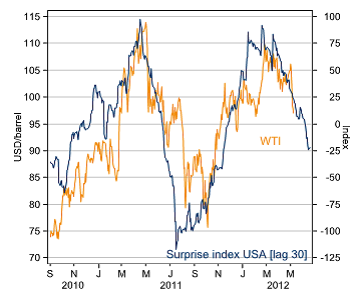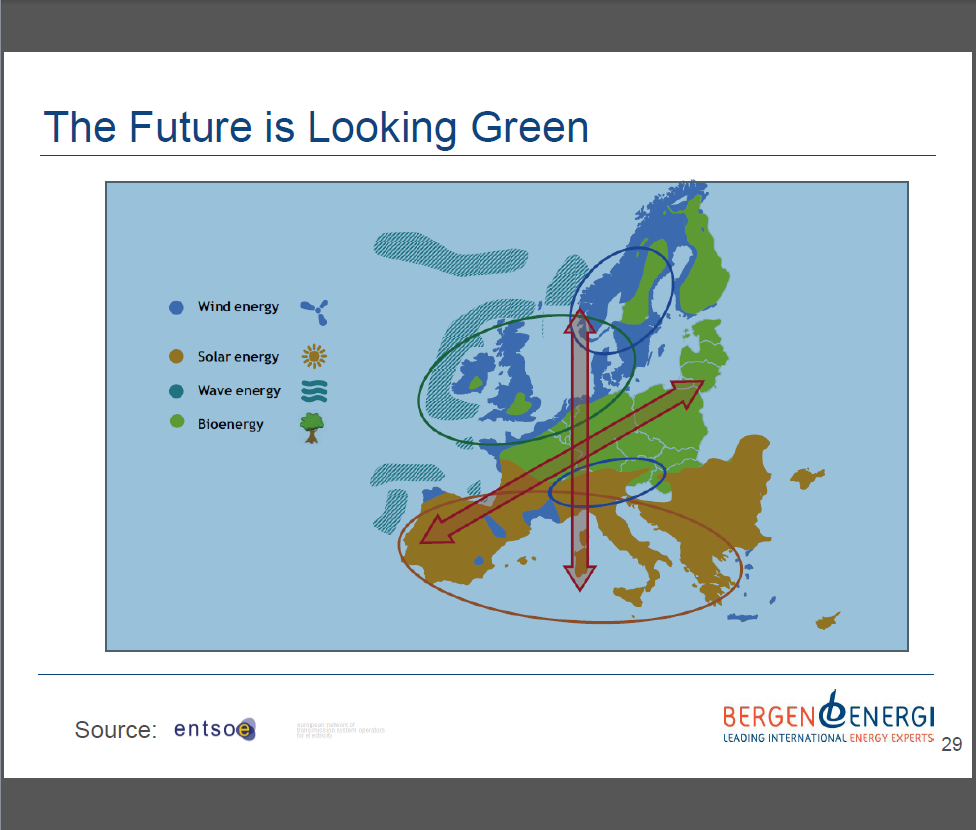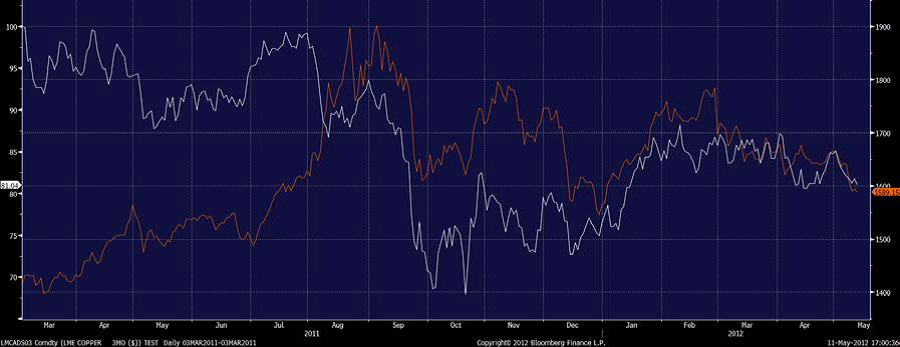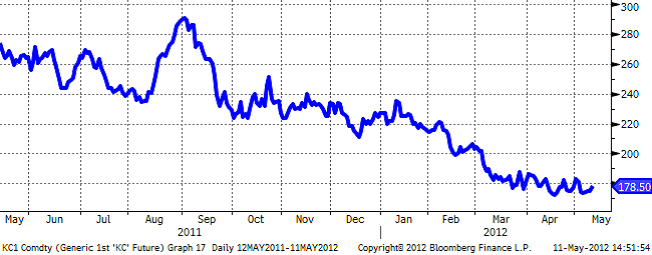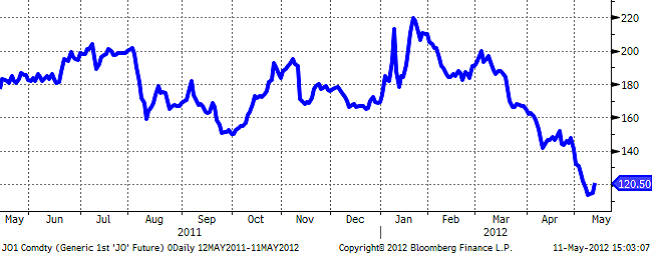Analys
SHB Råvarubrevet 11 maj 2012
 Råvaror Allmänt
Råvaror Allmänt
Våra vyer:
- Energi: Neutral
- Basmetaller: Neutral
- Ädelmetaller: Negativ
- Livsmedel: Neutral
Marknaden har präglats av svalare riskaptit senaste veckan. Råvaror har fallit tillsammans med börser och räntor medan krediter har fortsatt att surna. Den europeiska skuldkrisen har eskalerat så sakteliga och europeisk, amerikansk och kinesisk statistik har varit sämre än väntat. Vi tänker oss att europeisk statistik ska fortsätta att visa svaghet pga. finanspolitisk åtstramning. Kinas inbromsning blev uppenbar senast imorse med en industriproduktion som växte klart mindre än väntat. Sämre industritillväxt tillsammans med lägre inflation och ett fall i husförsäljningen ökar dock sannolikheten för att Kina lättar på penningpolitiken.
Även i USA emotser vi något dystrare data då tillväxten gavs skjuts av bland annat milt vinterväder tidigare i år. Bilden är dock inte entydig: kreditvillkoren lättar, kreditgivningen stiger och inköpschefsindex antyder förbättring.
Efter det grekiska parlamentsvalet är en ”grexit” åter på dagordningen. Trojkans nästa genomgång av Greklands uppfyllande av sina budget- och reformlöften stundar i sommar. Bland annat måste Grekland klubba nya åtstramningar värda omkring EUR12mdr (5% av landets BNP) innan utgången av juni för att uppfylla Trojkans krav för att säkerställa utbetalningarna.
Om inte Grekland eller Trojkan viker ned sig kommer statens underskott inte kunna finansieras. BNP skulle krympa. Sannolikt skulle även ECB vägra att acceptera grekiska tillgångar som säkerheter. Grekland kan då inte finansiera sin import, vilket riskerar att leda till bensin- och matbrist i takt med att importen kollapsar. För att kunna betala ut löner måste landet införa en ny valuta. Kontrakt och tillgångar skulle omdenomineras till den nya valutan. Olika underskott skulle då kunna finansieras genom centralbanken, dock med inflationära konsekvenser.
Energi (neutral)
Olja
På senare tid har det funnits mycket som talat för att oljepriset skulle falla tillbaka. Vad som överraskat oss är styrkan i senaste rörelsen. Idag talar mycket för att det är flera engångsfaktorer som inträffat simultant och bildat en ”perfekt storm” för att få priset på fall och vi ser nu, liksom tidigare att Brent har bra stöd omkring 100-110 dollar under resten av året.
- Den starka utvecklingen för amerikanska aktier har toppat och i takt med att makrodata i USA inte har överraskat positivt så har aktiemarknaden flackat ut på andra sidan atlanten och minskat det positiva sentimentet. Olja har följt samma mönster som USAs makrodata i förhållande till förväntningarna men med en månads eftersläpning. Se figur nedan.
- Amerikanska oljelager är på 21 års högsta efter boomen i oljeutvinning av skifferolja.
- Spekulativa positioner steg snabbt under Iran-konflikten och när spänningarna minskat mellan Iran, Israel och USA så har investerare sålt av olja.
- OPEC har ”pratat ner” oljan på ett sätt vi tidigare inte sett. Saudis oljeminister Ali al-Naimi har varit i Japan och påtalat att Saudi har 2,5 miljoner fat per dag i tillgänglig reservkapacitet (Saudi producerar idag 9,8 miljoner fat per dag) och har utöver det 80 miljoner fat i lager som är redo att skeppas ut närhelst det behövs. Ali al-Naimi upprepar också att OPEC vill ha ett pris på 100 USD. För att understryka att man menar allvar sänker Saudis statliga oljebolag Aramco sitt pris för juni för den viktigaste marknaden Asien.
Elmarknaden
Vi ligger kvar med vår korta position i tredje kvartalet Q3 2012 (underliggande för SHB Power Index) då sentimentet pekar fortsatt ned. Senaste väderprognoserna visar på nederbörd om mellan 6-11 TWh de kommande 10 dagarna (4TWh är normalt för årstiden) vilket kommer att förbättra energibalansen något ytterligare. Vidare får vi temperaturer under normalen vilket så här års innebär en smälttakt som ser till att vatten får behållas in mot hösten. Detta i kombination med en god balans bör hålla tredje kvartalet kvar på en låg nivå. Övriga faktorer som energikol i synnerhet men även övriga fossila bränslen samt utsläppsrätter verkar fortsatt också för nedsidan.
Några kommentarer från Energikonferens i Bergen
Vi har under onsdagen och torsdagen bevistat Bergen Energis årliga energikonferens. Speciellt intressant var professor Egil Lilliestols tankar om kärnkraftens framtid och John Brottemsmos föredrag om den framtida energibalansen i Europa.
Enligt IEA kommer den globala energiåtgången att öka med en tredjedel fram till 2035. Detta kommer givetvis ställa enorma krav på hur vi producerar energi i framtiden. British Petroleum har estimerat att med dagens förbrukning kommer oljan räcka i 46 år, naturgasen i 59 år och kolet i 118 år. Mycket resurser satsas idag på förnyelsebara energikällor (sol, vind, vatten) men problemet är att dessa energikällor inte producerar energi på ett stabilt och förutsägbart sätt. Till exempel hade Tyskland under 40 dagar under hösten 2011 mycket svårt att få balans i sitt energisystem. Vädret var torrt, mycket kallt och det blåste ingenting.
Professor Lillestad menade att förnyelsebar energi har en lysande framtid (om man satsar mycket stora summor på överföringskapacitet), men att det behövs en stabil bas, oavsett väder och vind. Han menar att endast kärnkraften kan stå för en sådan bas. Professorn propagerade för en nygammal form av kärnbränsle, thorium. Dagens reaktorer använder anrikat uran (plutonium), vilket innebär en hel mängd problem (slutförvaring, bombtillverkning av illasinnade stater/individer och en reaktor som är känslig för mänskliga fel/naturkatastrofer). Med thorium som bränsle blir reaktorn mycket säkrare och det skapas inga farliga restprodukter som måste förvaras i tusentals år.
Ytterligare fördelar är att thoriumreaktorer kan använda farligt plutonium som bränsle och skapa en relativt ofarlig restprodukt samt att det finns mycket mer thorium än uran i jordskorpan. Exempelvis skulle Norges kända thoriumreserver kunna täcka landets nuvarande elkonsumtion i 13 000 år!
John Brottemsmo, analytiker på Bergen Energi har analyserat Europas energibalans från ett efterfråge- och utbudsperspektiv. På efterfrågesidan ser han inget kraftigt ökande behov. Vi har ett skuldsatt Europa som måste spara sin väg ut ur skuldberget. Samtidigt kommer Europas befolkning minska framöver plus att den energiintensiva industriproduktionen kommer krympa framöver. Detta sammantaget talar för en ”lugn” efterfrågeökning i framtiden.
På utbudssidan finns det tyvärr större utmaningar. Kärnkraften står för en mindre och mindre del av Europas energimix och med Tysklands nedstängning ser det ännu sämre ut. Italien har röstat emot en start av deras reaktor och Schweiz har beslutat att stänga ned kärnkraften 2034. Däremot har Europa beslutat att bygga ut förnyelsebara energikällor kraftigt. Utmaningen med expansionen är att elnätet inte är utbyggt för en storskalig överföring av el nord-syd och sydväst-nordöst (se bild). Enorma summor måste investeras för att koppla ihop Europa i ett fungerande elnät.
Slutsatsen blir att elpriset (med hänsyn taget till inflation) inte kommer stiga kraftigt på grund av den modesta efterfrågeökningen, men att våra elfakturor kommer se annorlunda ut i framtiden. Idag består genomsnittskonsumentens elfaktura till 52 % av faktisk el. Resten är skatter, nätavgifter och vinster till eloperatörerna. År 2030 kommer istället nätkostnaderna uppgå till ca 50 %, att jämföra med dagens 30 %.
Basmetaller (neutral)
Basmetallerna har fortsatt att falla även denna vecka, vårt sektorindex för basmetaller är ned med 1,62 %. Oron för europa tillsammans med sämre än väntad statistik från USA, Kina och europa har pressat priserna. I veckan presenterades Kinas importsiffror för mars som visade att importen av koppar föll 18 % till lägsta nivån på 8 månader vilket tyder på att Kina använder sina höga lager. Nu är det lönsamt för kinesiska bolag att exportera koppar och vi kommer säkert få se att otullade volymer exporteras till LMEs lagerhus den kommande tiden. Vårt budskap sedan mars har varit att Kina behöver sälja ut lager av färdiga produkter och beta av lager av obearbetade råvaror. Data bekräftar att detta sker just nu och vi tror fortsatt att prisrisken för kinaexponerade råvaror ligger på nedsidan fram till Q3.
Ädelmetaller (Negativ)
Vi återtar vår negativa syn på ädelmetaller, drivet av att guldet fortsätter underprestera även när risksentimentet är så negativt som det är just nu. Alla dåliga nyheter vi fått oss serverade denna vecka hade för ett år sedan skickat upp guldpriset rejält, men denna vecka har det fortsatt att falla. Guldet har fallit med 3,5 %, och silvret (guldets busige lillebror) med över 5 %. Utöver vår gamla teori att marknaden blev lång på fel nivåer förra sommaren kan vi inte komma på en bättre förklaring än att guldet handlar som basmetallerna sedan 9 månader tillbaks. Bilden nedan visa guldpriset (röd linje) och kopparpriset (vit) som fram till det stora fallet i september rörde sig i stort sett diametralt mot varandra, för att därefter börja röra sig ganska lika. Under 2012 har de rört sig skrämmande lika… Vi får anledning att komma tillbaks med teorier om varför det blivit på detta sätt, men för idag nöjer vi oss med att konstatera: Guldet är inte värt att hålla som skydd mot riskaversion eller Eurokriser, inte heller som skydd mot börsfall. Inte just nu iallafall. Därför återtar vi – med självförtroende – vår negativa sektorvy på ädelmetaller!
Livsmedel (neutral)
Vete
Terminspriser på vete har i veckan gått ned något i både Chicago och Paris, gårdagens USDA-rapport bör ses som ganska neutral för vetet men viss negativ effekt kom från majsen. Vädret är fortsatt bra i USA, lite torrt till helgen men mer regn nästa vecka väntas. Vädret har förbättrats i Kanada och sådden pågår nu för fullt. I Australien uppges vädret generellt sett vara bra för sådd, men en del regioner önskar mer regn. I Europa har det tidigare varit lite väl regnigt i väst och lite väl torrt i öst – i nästa vecka ser förhållandet ut att skifta, vilket är klart önskvärt. Även i Ukraina, som tidigare varit lite väl torrt, faller en del nederbörd. Oron börjar däremot öka för Ryssland, torrt väder och dessutom stigande temperaturer utan något regn i sikte ger helt klart skäl till viss oro. Att sia om vetepriser framöver är ganska svårt, allt ser väldigt bra ut i USA och i Europa får situationen ses som ganska tillfredställande men i en del andra delar av världen ser det lite sämre ut – marknaden kommer följa väderutvecklingen i Ryssland väldigt noga framöver.
Majs
Majsen i Chicago har gått ned kraftigt under veckan, med nedgångar i terminskontrakt både för gammal och ny skörd. Gårdagens USDA-rapport, innehöll högre siffror för kommande skörd än väntat och även högre siffror för utgående lager för innevarande säsong. Sådden fortsätter snabbt i USA och väderförhållanden uppges vara idealiska både för sådd och för redan sådd majs – vilket behövs för att nå upp till dagens höga förväntningar. Om nuvarande prognoser infrias med bland annat fördubblat lager i USA så bör priserna gå ned ganska mycket, men det är lång tid till skörd och mycket kan hända – vädret har som bekant viss vana att överraska åt ena eller andra hållet.
Sojabönor
Sojapriserna i Chicago har gått ned i pris sedan förra veckan, påverkat bland annat av vinsthemtagning från höga nivåer men även av lägre priser på råolja och ökad oro för ekonomiska problem i Europa. Svagare brasiliansk valuta, lägsta på flera månader, har även det gett lite press på de amerikanska sojapriserna då det gör den brasilianska sojan mer attraktiv för utländska köpare. Fundamentalt sett är sojan fortfarande väldigt stark, inte minst med tanke på fortsatt ökande efterfrågan från Kina som köper soja av såväl gammal som ny skörd. USDA, spår en rekordhög kommande skörd i Sydamerika men det är väldigt långt till dess och väldigt mycket kan hända. Då den sydamerikanska skörden blev låg säsongen 2011/12 riktas efterfrågan till stor del mot soja från USA – vars sojalager ser ut att bli skrämmande litet vid utgången av säsongen 2012/13.
Softs
Kaffe
Kaffepriset fortsatte på sin förhållandevis låga prisnivå i början av veckan. Marknaden inväntar den brasilianska skörden, deras exportvolym och följer väderrapporterna från området. Mycket talar fortsättningsvis för goda brasilianska skördar men indikationer på ökad inhemsk konsumtion får marknaden att tvivla på högre exportsiffror. Mot slutet av veckan ser vi priset sakta stiga vilket verkar vara en reaktion på siffror som presenterats senare i veckan. Den rådande ekonomiska osäkerheten i Europa till trots räknar man med en på sikt ökad global kaffekonsumtion. Tyskland som är världens tredje största och Europas största kaffekonsument estimerar en ökad inhemsk kaffekonsumtion med 9,2 % per 2019. 2010 konsumerade tyskland 153,4 liter kaffe per capita, vilket översteg både landets vatten- och ölkonsumtion.
Socker
Socker handlades upp något i början av veckan till följd av det något torrare vädret i Brasilien och därmed risk för sämre skördar. Även en något ökad efterfrågan och rapporter om ökat antal lastfartyg vid de brasilianska hamnarna redo för lastning av råvaran fick priset att stiga. Det ekonomiska läget i Europa fick priset på socker att sjunka igen mot mitten av veckan och handlas fortsättningsvis lågt. Marknaden är något avvaktande inför brasilianska skördeperioden som inleds om bara några veckor, och inväntar även handeln inför ramadan som hittills varit modest. Ramadan inleds i juli och de muslimska länderna brukar fylla sina lager innan dess. Indien som förra veckan beslöt att tillåta obegränsad export av socker har inte publicerat sin planerade exportvolym. Indiens skördar är goda i år och det socker de inte exporterar i år har de möjlighet att lagra för export nästa år, vilket i sin tur kan påverka priset på sikt.
Apelsinjuice
Priset på apelsinjuice fortsätter vara lågt, utbudet överstiger efterfrågan kraftigt och de ökade oroligheterna i Europa den gångna veckan fick en allt annat än positiv reaktion på priset. Väderleksrapporterna i början av veckan talade för regn i Florida den kommande 10 dagars perioden, gynnsamt för skörden men även detta negativt för prisutvecklingen. Man talar om apelsinjuice som den ”sämst presterande råvaran 2012”. Mot slutet av veckan har vi sett en mindre prisuppgång baserat på nya rapporter inför Floridas orkansäsong. Orkansäsongen sträcker sig från 1 juli till 30 november och tros i år bjuda på 12 namngivna orkaner. Antalet orkaner är visserligen mindre än tidigare år men räckte för att påminna marknaden om att orkansäsongen är på ingång och det räcker med en större orkan för att orsaka avsevärda skador på skörden.
Handelsbankens Råvaruindex
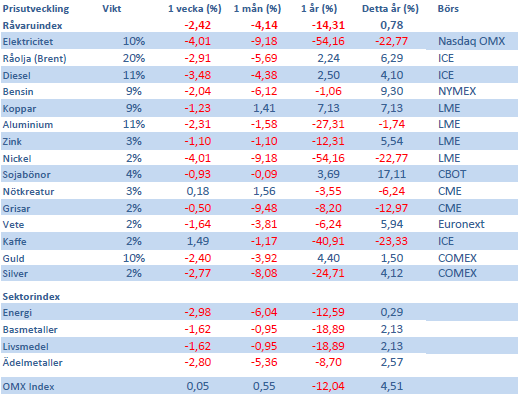
Handelsbankens råvaruindex består av de underliggande indexen för respektive råvara. Vikterna är bestämda till hälften från värdet av global produktion och till hälften från likviditeten i terminskontrakten.
[box]SHB Råvarubrevet är producerat av Handelsbanken och publiceras i samarbete och med tillstånd på Råvarumarknaden.se[/box]
Ansvarsbegränsning
Detta material är producerat av Svenska Handelsbanken AB (publ) i fortsättningen kallad Handelsbanken. De som arbetar med innehållet är inte analytiker och materialet är inte oberoende investeringsanalys. Innehållet är uteslutande avsett för kunder i Sverige. Syftet är att ge en allmän information till Handelsbankens kunder och utgör inte ett personligt investeringsråd eller en personlig rekommendation. Informationen ska inte ensamt utgöra underlag för investeringsbeslut. Kunder bör inhämta råd från sina rådgivare och basera sina investeringsbeslut utifrån egen erfarenhet.
Informationen i materialet kan ändras och också avvika från de åsikter som uttrycks i oberoende investeringsanalyser från Handelsbanken. Informationen grundar sig på allmänt tillgänglig information och är hämtad från källor som bedöms som tillförlitliga, men riktigheten kan inte garanteras och informationen kan vara ofullständig eller nedkortad. Ingen del av förslaget får reproduceras eller distribueras till någon annan person utan att Handelsbanken dessförinnan lämnat sitt skriftliga medgivande. Handelsbanken ansvarar inte för att materialet används på ett sätt som strider mot förbudet mot vidarebefordran eller offentliggörs i strid med bankens regler.
Analys
Tightening fundamentals – bullish inventories from DOE

The latest weekly report from the US DOE showed a substantial drawdown across key petroleum categories, adding more upside potential to the fundamental picture.

Commercial crude inventories (excl. SPR) fell by 5.8 million barrels, bringing total inventories down to 415.1 million barrels. Now sitting 11% below the five-year seasonal norm and placed in the lowest 2015-2022 range (see picture below).
Product inventories also tightened further last week. Gasoline inventories declined by 2.1 million barrels, with reductions seen in both finished gasoline and blending components. Current gasoline levels are about 3% below the five-year average for this time of year.
Among products, the most notable move came in diesel, where inventories dropped by almost 4.1 million barrels, deepening the deficit to around 20% below seasonal norms – continuing to underscore the persistent supply tightness in diesel markets.
The only area of inventory growth was in propane/propylene, which posted a significant 5.1-million-barrel build and now stands 9% above the five-year average.
Total commercial petroleum inventories (crude plus refined products) declined by 4.2 million barrels on the week, reinforcing the overall tightening of US crude and products.


Analys
Bombs to ”ceasefire” in hours – Brent below $70

A classic case of “buy the rumor, sell the news” played out in oil markets, as Brent crude has dropped sharply – down nearly USD 10 per barrel since yesterday evening – following Iran’s retaliatory strike on a U.S. air base in Qatar. The immediate reaction was: “That was it?” The strike followed a carefully calibrated, non-escalatory playbook, avoiding direct threats to energy infrastructure or disruption of shipping through the Strait of Hormuz – thus calming worst-case fears.

After Monday morning’s sharp spike to USD 81.4 per barrel, triggered by the U.S. bombing of Iranian nuclear facilities, oil prices drifted sideways in anticipation of a potential Iranian response. That response came with advance warning and caused limited physical damage. Early this morning, both the U.S. President and Iranian state media announced a ceasefire, effectively placing a lid on the immediate conflict risk – at least for now.
As a result, Brent crude has now fallen by a total of USD 12 from Monday’s peak, currently trading around USD 69 per barrel.
Looking beyond geopolitics, the market will now shift its focus to the upcoming OPEC+ meeting in early July. Saudi Arabia’s decision to increase output earlier this year – despite falling prices – has drawn renewed attention considering recent developments. Some suggest this was a response to U.S. pressure to offset potential Iranian supply losses.
However, consensus is that the move was driven more by internal OPEC+ dynamics. After years of curbing production to support prices, Riyadh had grown frustrated with quota-busting by several members (notably Kazakhstan). With Saudi Arabia cutting up to 2 million barrels per day – roughly 2% of global supply – returns were diminishing, and the risk of losing market share was rising. The production increase is widely seen as an effort to reassert leadership and restore discipline within the group.
That said, the FT recently stated that, the Saudis remain wary of past missteps. In 2018, Riyadh ramped up output at Trump’s request ahead of Iran sanctions, only to see prices collapse when the U.S. granted broad waivers – triggering oversupply. Officials have reportedly made it clear they don’t intend to repeat that mistake.
The recent visit by President Trump to Saudi Arabia, which included agreements on AI, defense, and nuclear cooperation, suggests a broader strategic alignment. This has fueled speculation about a quiet “pump-for-politics” deal behind recent production moves.
Looking ahead, oil prices have now retraced the entire rally sparked by the June 13 Israel–Iran escalation. This retreat provides more political and policy space for both the U.S. and Saudi Arabia. Specifically, it makes it easier for Riyadh to scale back its three recent production hikes of 411,000 barrels each, potentially returning to more moderate increases of 137,000 barrels for August and September.
In short: with no major loss of Iranian supply to the market, OPEC+ – led by Saudi Arabia – no longer needs to compensate for a disruption that hasn’t materialized, especially not to please the U.S. at the cost of its own market strategy. As the Saudis themselves have signaled, they are unlikely to repeat previous mistakes.
Conclusion: With Brent now in the high USD 60s, buying oil looks fundamentally justified. The geopolitical premium has deflated, but tensions between Israel and Iran remain unresolved – and the risk of missteps and renewed escalation still lingers. In fact, even this morning, reports have emerged of renewed missile fire despite the declared “truce.” The path forward may be calmer – but it is far from stable.
Analys
A muted price reaction. Market looks relaxed, but it is still on edge waiting for what Iran will do

Brent crossed the 80-line this morning but quickly fell back assigning limited probability for Iran choosing to close the Strait of Hormuz. Brent traded in a range of USD 70.56 – 79.04/b last week as the market fluctuated between ”Iran wants a deal” and ”US is about to attack Iran”. At the end of the week though, Donald Trump managed to convince markets (and probably also Iran) that he would make a decision within two weeks. I.e. no imminent attack. Previously when when he has talked about ”making a decision within two weeks” he has often ended up doing nothing in the end. The oil market relaxed as a result and the week ended at USD 77.01/b which is just USD 6/b above the year to date average of USD 71/b.

Brent jumped to USD 81.4/b this morning, the highest since mid-January, but then quickly fell back to a current price of USD 78.2/b which is only up 1.5% versus the close on Friday. As such the market is pricing a fairly low probability that Iran will actually close the Strait of Hormuz. Probably because it will hurt Iranian oil exports as well as the global oil market.
It was however all smoke and mirrors. Deception. The US attacked Iran on Saturday. The attack involved 125 warplanes, submarines and surface warships and 14 bunker buster bombs were dropped on Iranian nuclear sites including Fordow, Natanz and Isfahan. In response the Iranian Parliament voted in support of closing the Strait of Hormuz where some 17 mb of crude and products is transported to the global market every day plus significant volumes of LNG. This is however merely an advise to the Supreme leader Ayatollah Ali Khamenei and the Supreme National Security Council which sits with the final and actual decision.
No supply of oil is lost yet. It is about the risk of Iran closing the Strait of Hormuz or not. So far not a single drop of oil supply has been lost to the global market. The price at the moment is all about the assessed risk of loss of supply. Will Iran choose to choke of the Strait of Hormuz or not? That is the big question. It would be painful for US consumers, for Donald Trump’s voter base, for the global economy but also for Iran and its population which relies on oil exports and income from selling oil out of that Strait as well. As such it is not a no-brainer choice for Iran to close the Strait for oil exports. And looking at the il price this morning it is clear that the oil market doesn’t assign a very high probability of it happening. It is however probably well within the capability of Iran to close the Strait off with rockets, mines, air-drones and possibly sea-drones. Just look at how Ukraine has been able to control and damage the Russian Black Sea fleet.
What to do about the highly enriched uranium which has gone missing? While the US and Israel can celebrate their destruction of Iranian nuclear facilities they are also scratching their heads over what to do with the lost Iranian nuclear material. Iran had 408 kg of highly enriched uranium (IAEA). Almost weapons grade. Enough for some 10 nuclear warheads. It seems to have been transported out of Fordow before the attack this weekend.
The market is still on edge. USD 80-something/b seems sensible while we wait. The oil market reaction to this weekend’s events is very muted so far. The market is still on edge awaiting what Iran will do. Because Iran will do something. But what and when? An oil price of 80-something seems like a sensible level until something do happen.
-

 Nyheter3 veckor sedan
Nyheter3 veckor sedanStor uppsida i Lappland Guldprospekterings aktie enligt analys
-

 Nyheter4 veckor sedan
Nyheter4 veckor sedanBrookfield ska bygga ett AI-datacenter på hela 750 MW i Strängnäs
-

 Nyheter3 veckor sedan
Nyheter3 veckor sedanSilverpriset släpar efter guldets utveckling, har mer uppsida
-

 Nyheter3 veckor sedan
Nyheter3 veckor sedanUppgången i oljepriset planade ut under helgen
-

 Nyheter3 veckor sedan
Nyheter3 veckor sedanLåga elpriser i sommar – men mellersta Sverige får en ökning
-

 Analys3 veckor sedan
Analys3 veckor sedanVery relaxed at USD 75/b. Risk barometer will likely fluctuate to higher levels with Brent into the 80ies or higher coming 2-3 weeks
-

 Nyheter2 veckor sedan
Nyheter2 veckor sedanMahvie Minerals växlar spår – satsar fullt ut på guld
-

 Nyheter1 vecka sedan
Nyheter1 vecka sedanOljan, guldet och marknadens oroande tystnad


